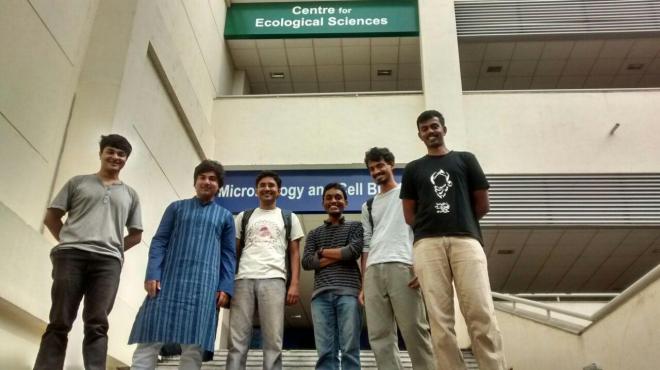Farewell to several students! Its one of those bitter-sweet blog posts. Various short-term students who have made substantial contributions to the lab are moving forward. Here is a brief farewell for them! Four undergraduate (UG) students from the first batch of IISc’s four year UG program worked with me for their final year project. Two others who have moved on are Pratik Gupte and Subhankar Chakraborty, both of whom did tremendous work in setting up fish lab for us.

(from left: Pratik, Nikunj, Vishu, Amitabh, Visweswaran, Athma)
Amitabh Srivastava, a physics major at IISc and an electronic and engineering geek, joined our lab in Oct 2014. He built two drones (a hexacopter and a fixed wing flight) and a very cool elephant height sensor (working with a postdoc, Karpagam Chellaiah, in our lab). He is expected to publish at least one paper describing his novel design of elephant sensor. He is joining a start up in Bangalore that makes cool toys based on cool and simple physics.
Athmanathan (Athma), a math major, first worked with me in his very first year summer for a short project in 2012, and then in the summer of 2013. For his final year project, he jointly worked with me and Srikanth Iyer (mathematics department) on developing a mathematical model for animal grouping with heterogeneous agents. He will be joining a PhD program in Ecology at the University of Tennessee, Knoxville.
Nikunj Goel, a physics major, started working with me almost two years ago in the summer of 2013 building a physical model of critical transitions that won an award! He worked with me and my economics collaborator Srinivas Raghavendra on analysing financial data in the context of critical transitions. For his bachelor’s thesis, he proposed a new early warning signal for abrupt transitions in complex systems and also analyzed a bunch of real data sets. Nikunj will be joining a PhD program in Ecology at Yale University.
Visweswaran was the only bio major of the IISc UG batch to have worked in our lab! He initially tried to work on biofilm experiments and modelling, and finally switched to modelling how scale and strength of ecological interactions affect spatial pattern formation. He is continuing in IISc to get a BS-MS dual degree and will work with my colleague Narendra Dixit of Chemical Engineering department for his masters thesis.
Subhankar Chakraborty, coming from a conservation genetics background, did tremendous work in setting up our experimental lab, navigating through the logistical nightmares of procuring fish, transporting from Kerala and sometimes as far place as West Bengal, working with vendors on setting up aquariums, holding racks, etc. All this required patience that only Subho could have. He is now moving on to more important things in life, and we are waiting to hear about them!
Pratik joined the lab for a short internship from Jan 2015 and worked on experimental set up. He is most famous for his naps in the lab meetings, my classes, and remarkable ways in which he could resolve tricky experimental set up issues. He will be joining a Masters program in Europe (Erasmus Mundus program in Applied Ecology).
The lab will miss all of you, but have a great time ahead. All the best folks.














